This group of parasites, like the Monogenea, is commonly referred to as "flukes", but these are internal parasites and all have multiple-host life cycles. All members are parasitic.
With almost no exceptions, digeneans have a vertebrate definitive host and a mollusc first intermediate host. Additional hosts may be involved. The name "digenea" refers to the alternation of generations between sexually-reproducing adult and asexually reproducing larval stages. This contrasts with the Monogenea, which reproduce sexually only.
Adults produce an egg. Subsequent development follows myriad routes, depending on the species involved. A miracidium develops within the egg, and may hatch in water and swim until it can penetrate a mollusc first intermediate host, or the egg may be eaten by a mollusc and then hatch. The miracidium develops through mother (and possibly daughter) sporocyst stages, and/or mother (and possibly daughter) redia stages, all of which are capable of asexual proliferation in the mollusc. Whichever path is followed, the final product is a larval form called a cercaria, which is usually a swimming stage that may encyst on vegetation as a metacercaria, or may penetrate or be eaten by another host, and then develop in that host to the metacercaria stage. A few species have a mesocercaria stage between the cercaria and metacercaria. The metacercaria develops into an adult when it is eaten by a definitive host.
The adult body form is usually oval and flattened. The reproductive system has a common basic structure and set of connections, with variations mainly taking the form of different numbers and spatial arrangements of components.
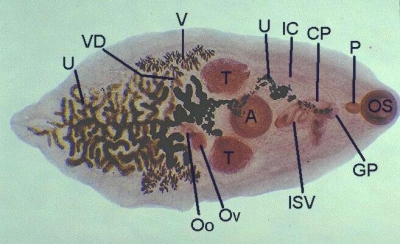
There is no body cavity; the body is covered externally by a tegument, and internal organs are suspended within a parenchyma. The body surface may be smooth or spined. There is usually an oral sucker (OS) which is used for feeding and also as an aid for attachment, along with other modifications such as spines, hooks or glands. There is usually a ventral sucker, the acetabulum (A), which may be present at mid- or hind-body but is occasionally absent.
The digestive system is incomplete, with a mouth, esophagus, pharynx (P) and blind- ending intestinal ceca (IC) which may be diverticulate. Excretory ducts are present, emptying into an excretory bladder in some taxa. A nervous system is present, although it is difficult to visualize. Photoreceptors are present in free-living stages of some taxa.
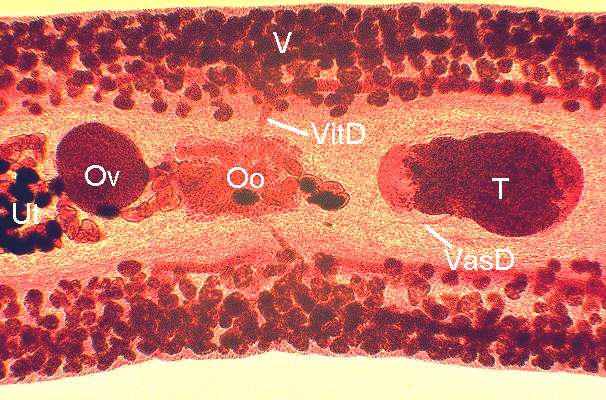
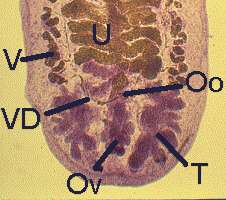
Most digeneans are hermaphroditic, with one set of reproductive systems per individual. A few taxa are dioecious.
The male reproductive system comprises various numbers (usually 2) of testes (T), connected by vasa efferentia to a common vas deferens (VasD), which then enters a cirrus pouch (CP) and then a cirrus. The vas deferens may be enlarged for sperm storage outside and inside the cirrus pouch, called external and internal (ISV) seminal vesicles, respectively. The cirrus, which delivers sperm to the female system, may be retractable and may be covered with spines.
The female reproductive system comprises a number of structures meeting in a region called the ootype (Oo). An ovary (Ov) produces oocytes which are carried to the ootype via an oviduct. Vitelline glands (V) are present as a field of separate follicles found in lateral fields. They produce nutritive and shell materials that are carried via vitelline ducts (VD, VitD) to the ootype where they are incorporated into eggs. Sperm are received via the uterine pore. A Mehli's gland may surround the ootype. Fully-formed eggs exit the ootype and accumulate in a uterus (U, Ut).
The male and female reproductive systems share a common genital pore (GP).
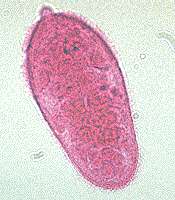
The digenean miracidium is ciliated, and its prominent internal features include eyespots, various penetration glands, and numerous excretory cells and tubules. Sporocysts are simple, tubular or branched germinal sacs.
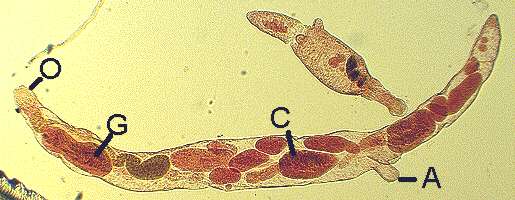
Rediae are tubular germinal sacs which possess an oral sucker (O) and rudimentary digestive system (G), a birth pore, and small ambulatory appendages (A). This one contains developing cercariae (C)

Cercariae resemble miniature adults, with a similar body shape, digestive system and ornamentation to the adults they will become. Cercariae have only the rudiments of their reproductive systems, but most possess some sort of penetration glands or stylets near the mouth, and some sort of tail (which takes on numerous forms and is useful for identification.)
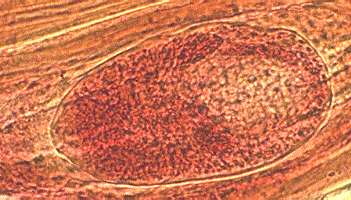
Metacercariae usually resemble the cercariae from which they developed, without the tail, and may be enclosed in a clear cyst.